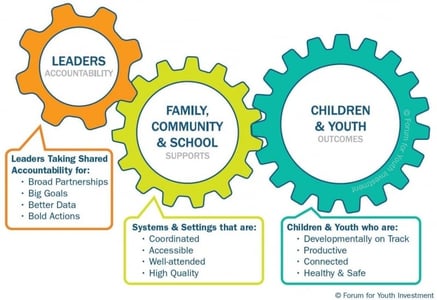For more than a decade, the Forum for Youth Investment has helped communities map, convene and align coalitions and initiatives focused on the interlocking issues that affect young people's futures, from premature births to college completion.

Cast the net widely enough, and even the smallest communities can identify dozens of efforts with overlapping goals, members, strategies and funders. Cast the net narrowly, and those same communities are likely to find that there is more than one coalition focused on early childhood or violence prevention that have never sat together to discuss how their work overlaps.
The underlying tenets of the collective impact approach call this type of benign coexistence into question. Alignment is essential to success. As leaders in communities explore how to implement collective impact strategies, the "how to align" questions are right at the top of the list, quickly followed by questions such as "Who initiates the process?" "Who facilitates it?" "How long does it take?" "Is there a way to anticipate what's needed and have supports ready?" and "How do you manage expectations?"
So, where to start?
Step 1. Be clear on why you're starting alignment discussions.
Typically, the alignment question surfaces at a decision point where it's appropriate to ask, "Is there a better way?" To be effective, the focus of the conversations begins and ends with "in order to make a more powerful impact." Aligning goals, agreeing on shared measurement and shared diagnosis of the issues and, ultimately, aligning how to work together is all about finding better ways to change outcomes more quickly and at scale.
Step 2. Be clear about the range of alignment options.
Formal structural alignment isn't always the immediate goal and might not be the best longterm solution. Aligning for impact should be seen as an ongoing commitment, not a quick structural decision. Alignment isn't just about who gets to be the backbone when there is more than one candidate. It's about helping all the current efforts contribute to progress toward a shared goal. It is as important for the structure to emerge from shared seeing and learning as it is for the strategies.
Step 3. Be clear on what it will take to manage the process and how long it may take to complete it.
Aligning existing initiatives is hard and sensitive work. A good rule of thumb: The more alike the initiatives, the harder and more sensitive the work. When deeper types of alignment are likely, the alignment process typically takes six months to negotiate and a year or more to implement fully. For deeper alignments, we recommend that the process be guided by a trusted, neutral advisor.
Step 4. Document decisions and anticipate their impact.
Aligning existing initiatives is hard work. The payoffs are greater efficiency, effectiveness and/or scale. Documenting decisions and tracking what gets done is critical to effective partnerships. As groups make decisions about the systems to support their shared measurement, it is essential to identify not only outcomes and community supports, but also methods to track the partnership's decisions, actions and progress.
Working through these steps will help you lay the groundwork for making your collective impact work more efficient and effective.
Access the full article How to Partner for Impact: The Nuts and Bolts of Aligning Collective Impact Efforts
Listen to the webinar that spurred this article Too Much Collective, Too Little Impact





